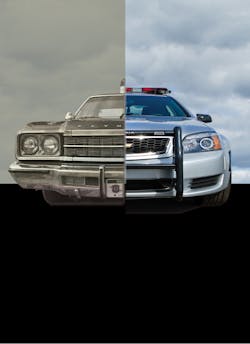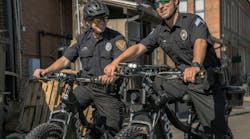Once again this past September, the Michigan State Police (MSP) Precision Driving Team conducted their annual evaluation of next year’s models of police vehicles. The tests were designed to provide an unbiased source of data—the responsibility of analyzing results is up to each agency to decipher and match the “best” vehicle to its mission.
Tests involved determining the average deceleration rate (braking), calculating a stopping distance in feet from going 60 MPH, top speed, timing the average seconds it takes the vehicle to reach certain speeds (acceleration), and a street course (dynamics) to emulate the vehicle’s capability in highway—or freeway—like driving. In this article we present the acceleration to 60 MPH to match the brake testing, but MSP’s data does go up to 100. If you’re interested, MSP publishes their data free online. All results printed here should be considered preliminary and are subject to change upon verification of data.
The tests are not designed to discern a winner, nor were they ever designed to resemble a race. Yet, top performances are difficult to overlook. In braking, the three-wheeled Can-Am Spyder looks to stop shortest at a projected 118.9 feet from a 60 MPH speed. Yet, the Harley-Davidson Road King recorded the shortest deceleration rate of the motorcycles (28.16) and second of the entire group. On the flip side, Ford’s Utility 3.5L Ecoboost all-wheel drive accelerated to 60 MPH quickest as far as SUVs go. One of the Dodge Charger 5.7s had a top projected distance for a vehicle, however, at 123.2 feet.
But if get-up-and-go sounds more up your alley, check out the 2017 BMW R 1200 RT-P—once again it ended up the quickest motorcycle with both top speed (136 MPH) and acceleration to 60 (4.31 seconds). In comparison, the Chevrolet Caprice 6 liter was able to reach 155 MPH, while the Ford Police Interceptor Sedan 3.5 liter Ecoboost all-wheel drive was able to reach the 60 MPH mark quickest in 5.7 seconds.
Grattan Raceway’s two mile road course returned a difference of about eight seconds between quickest time to least. It may have had to do with the acceleration capability, but the Ford Police Interceptor 3.5 liter Ecoboost all wheel drive recorded an average lap time of 1:35.34 seconds with the always nimble BMW R 1200 RT-P clocking a 1:39.14. What does four seconds per mile mean to you?
But First, the Results
Brake Testing
|
Overall Average
|
Projected Stopping Distance
|
|
| BMW R 1200 RT-P |
28.55 |
135.6 |
| Can-AM Spyder F3P |
32.57 |
118.9 |
| Chevrolet Caprice 3.6L RWD |
30.38 |
127.4 |
| Chevrolet Caprice 6.0L RWD |
30.47 |
127.1 |
| Chevrolet Tahoe 5.3L RWD |
28.12 |
137.7 |
| Chevrolet Tahoe 5.3L 4WD |
28.62 |
135.3 |
| Dodge Charger 3.6L 2.62 RWD |
30.95 |
125.1 |
| Dodge Charger 5.7L 2.62 RWD |
31.43 |
123.2 |
| Dodge Charger 5.7L 3.08 AWD |
30.23 |
128.1 |
| Ford SSP Sedan 2.0L Ecoboost FWD |
30.02 |
129 |
| Ford PI Sedan 3.5L FWD |
30.44 |
127.2 |
| Ford PI Sedan 3.7L AWD |
29.76 |
130.1 |
| Ford PI Sedan 3.5L Ecoboost AWD |
29.58 |
130.9 |
| Ford PI Utility 3.7L AWD |
30.45 |
127.1 |
| Ford PI Utility 3.5L Ecoboost AWD |
30.32 |
127.7 |
| Harley-Davidson Electra Glide |
28.68 |
135 |
| Harley-Davidson Road King |
28.16 |
137.5 |
| Harley-Davidson Electra Glide, Stage 3 |
28.28 |
136.9 |
| Zero Motorcycles DSRP |
n/a |
142.7 |
Acceleration / Top Speed
| Top Speed (MPH) | 0 to 60 MPH (seconds) | |
| BMW R 1200 RT-P |
136 |
4.31 |
| Can-AM Spyder F3P |
120 |
5.76 |
| Chevrolet Caprice 3.6L RWD |
147 |
7.91 |
| Chevrolet Caprice 6.0L RWD |
155 |
6.11 |
| Chevrolet Tahoe 5.3L RWD |
132 |
7.97 |
| Chevrolet Tahoe 5.3L 4WD |
121 |
8.08 |
| Dodge Charger 3.6L 2.62 RWD |
142 |
8.06 |
| Dodge Charger 5.7L 2.62 RWD |
150 |
6.17 |
| Dodge Charger 5.7L 3.08 AWD |
150 |
6.05 |
| Ford SSP Sedan 2.0L Ecoboost FWD |
120 |
8.26 |
| Ford PI Sedan 3.5L FWD |
133 |
7.78 |
| Ford PI Sedan 3.7L AWD |
133 |
7.43 |
| Ford PI Sedan 3.5L Ecoboost AWD |
150 |
5.7 |
| Ford PI Utility 3.7L AWD |
132 |
7.99 |
| Ford PI Utility 3.5L Ecoboost AWD |
130 |
6.4 |
| Harley-Davidson Electra Glide |
109 |
5.38 |
| Harley-Davidson Road King |
110 |
5.42 |
| Harley-Davidson Electra Glide, Stage 3 |
110 |
4.43 |
| Zero Motorcycles DSRP |
n/a |
n/a |
Dynamic / Road Lap Times
| Overall Average | |
| BMW R 1200 RT-P |
1:39.14 |
| Can-AM Spyder F3P |
1:57.73 |
| Chevrolet Caprice 3.6L RWD |
1:39.76 |
| Chevrolet Caprice 6.0L RWD |
1:37.58 |
| Chevrolet Tahoe 5.3L RWD |
1:39.75 |
| Chevrolet Tahoe 5.3L 4WD |
1:40.6 |
| Dodge Charger 3.6L 2.62 RWD |
1:38.26 |
| Dodge Charger 5.7L 2.62 RWD |
1:37.12 |
| Dodge Charger 5.7L 3.08 AWD |
1:36.53 |
| Ford SSP Sedan 2.0L Ecoboost FWD |
1:43.05 |
| Ford PI Sedan 3.5L FWD |
1:38.82 |
| Ford PI Sedan 3.7L AWD |
1:38.01 |
| Ford PI Sedan 3.5L Ecoboost AWD |
1:35.34 |
| Ford PI Utility 3.7L AWD |
1:40.93 |
| Ford PI Utility 3.5L Ecoboost AWD |
1:38.53 |
| Harley-Davidson Electra Glide |
1:49.5 |
| Harley-Davidson Road King |
1:50.41 |
| Harley-Davidson Electra Glide, Stage 3 |
1:48.19 |
| Zero Motorcycles DSRP |
1:46.4 |
Editor’s Note: All published results are preliminary and are subject to change upon verification of the data. Any calculated results on consistency are internal. An incident during the evaluation process kept the Zero DSRP from completing the full range of tests.
About that $4
In my interview with one of the MSP drivers of the Precision Driving Unit, Sgt. Michael McCarthy was able to give me the story of how the vehicle evaluation event began. Back in the day (a Wednesday, I believe), MSP were hired during World War I to secure Michigan’s iron mines. Afterward they were kept on as the police force. “It was all horseback back then, there wasn’t any mechanization when we started off,” he says.
Then, in a way, prohibition bought MSP their first patrol vehicles with seized bootlegger cars being used for patrol. “We didn’t necessarily buy our first cars,” jokes McCarthy. “It just happened to be whatever we ended up [in] possession of.”
By the late 1940s to 1950s the agency began requesting bids for vehicle manufacturers. Not wanting to go blind into a purchase, they then started their testing. Low-bid cars were put out to determine whether or not they would be suitable for police work. “They would actually only test the low bid car and as long as it was acceptable they purchased more,” says McCarthy.
The story takes a turn in late 1950s, where $4 was the difference between the lowest bid vehicles—making one wonder what performance would be gained by another $4. How else to know if not test both?
That continued until 20 years later, “the testing as it is known today, the one that we consider our ‘first’ year was 1975,” says McCarthy. “Other than the equipment used, [this test program] was the same since.” Acceleration, deceleration rates, top speed, and a dynamic course has been—and will be for the foreseeable future—a mainstay in the Michigan State Police Vehicle Tests and Evaluations.
Over a hundred or more attend the event now, but early-on it wasn’t always a popular expectation. McCarthy explains that about five people came to watch the first year. The following year brought 30 or so. The story goes, he says, that one of the vehicle manufacturers observing the hungry mass suggested serving food. The tradition stuck. Today each manufacturer is held responsible for one of three meals—a breakfast, a lunch that same day, or a lunch at the Grattan Raceway.
Just like the cars themselves, the testing equipment changed. The original program was conducted with tape measures, stop watches, and cones. For example, to determine stopping distance, drivers would brake at the set cone and the distance to full stop was measured. Wanting to be a bit more scientific, the team later mounted a fifth wheel on the vehicle capable of measuring distance as well as speed.
The braking and acceleration evaluations have been—and are still today—conducted at the Chrysler Proving Grounds. The dynamic road course, on the other hand, moved around a bit. The course started by utilizing the road course just outside the Michigan International Speedway. Due to deterioration and decreasing road conditions, the testing vehicle dynamics were moved to Grattan. The speedway’s site reports that the last time the exterior road course was “officially” used was 1973.
One of the iconic images of law enforcement vehicles includes just two wheels, yet motorcycles weren’t introduced into the testing program until September 2006, for the 2007 model years. More recent years moved the motorcycle course from the MSP training grounds to the same Grattan Raceway.
They’re still using cones but opted to push the envelope in accuracy as years went by. “We [then] went to a company called Datron. They used a non-contact optical sensor,” says McCarthy. It recorded the vehicle’s speed and distance by detecting the ground as it moved past the lens. “It became much more accurate than clicking the stop watch as fast as you can.”
With a new year came another measuring equipment change, and MSP looked to the skies for help. “Now we’re actually using GPS-based equipment to do measurement, which is fairly equally accurate, but the mounting system is not nearly as detailed,” says McCarthy. Potentially taking operator or mounting error out of the equation, the device uses magnets to attach to the vehicle. “It doesn’t require any type of trailer hitch, adapter, or tension devices.” So the event effectively went from stop watches and tape to satellites and space.
Will the program change?
McCarthy doesn’t foresee any immediate need to change the testing. But that doesn’t mean the world isn’t changing. All-electric vehicles have been introduced, the Zero Motorcycles DSRP and E85 capable machines for example—if the mission changes due to technology, then the you’ll see changes in your vehicles as well. McCarthy looks to the future of police patrol vehicles: “Different power technologies, different abilities…I think alternative energies would a good place, [and] probably all of [the major vehicle manufacturers] are investigating.”
If analyzed right, great performances on the track could say tomes of the vehicle, but the story may read differently for each agency. McCarthy notes, “It all depends on the mission as to what’s the best patrol car.”



